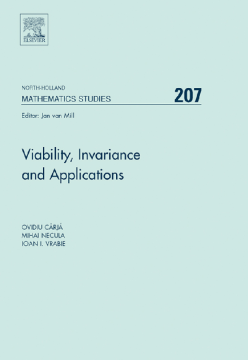
Additional Information
Book Details
Abstract
The book is an almost self-contained presentation of the most important concepts and results in viability and invariance. The viability of a set K with respect to a given function (or multi-function) F, defined on it, describes the property that, for each initial data in K, the differential equation (or inclusion) driven by that function or multi-function) to have at least one solution. The invariance of a set K with respect to a function (or multi-function) F, defined on a larger set D, is that property which says that each solution of the differential equation (or inclusion) driven by F and issuing in K remains in K, at least for a short time.
The book includes the most important necessary and sufficient conditions for viability starting with Nagumo’s Viability Theorem for ordinary differential equations with continuous right-hand sides and continuing with the corresponding extensions either to differential inclusions or to semilinear or even fully nonlinear evolution equations, systems and inclusions. In the latter (i.e. multi-valued) cases, the results (based on two completely new tangency concepts), all due to the authors, are original and extend significantly, in several directions, their well-known classical counterparts.
- New concepts for multi-functions as the classical tangent vectors for functions
- Provides the very general and necessary conditions for viability in the case of differential inclusions, semilinear and fully nonlinear evolution inclusions
- Clarifying examples, illustrations and numerous problems, completely and carefully solved
- Illustrates the applications from theory into practice
- Very clear and elegant style
"This book deals with a systematic treatment of those tangency conditions in connection with viability or invariance problems of increasing generality, together with some applications of the previously developed abstract theory. The material is presented in a very clear and well-organized way." --Zentralblatt MATH, 2012
